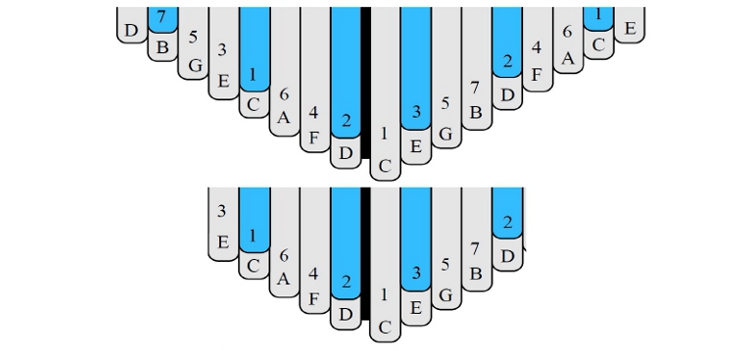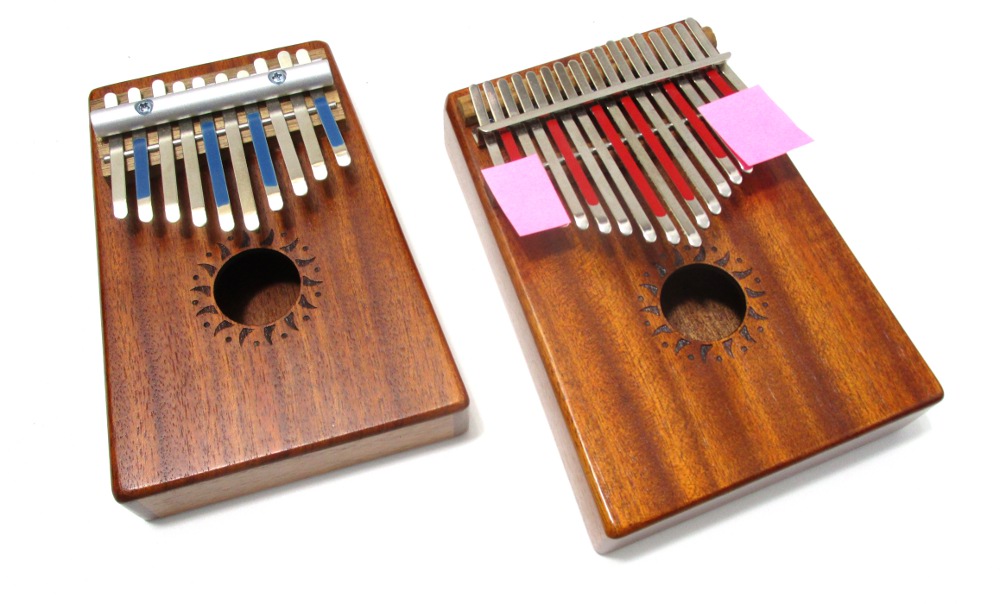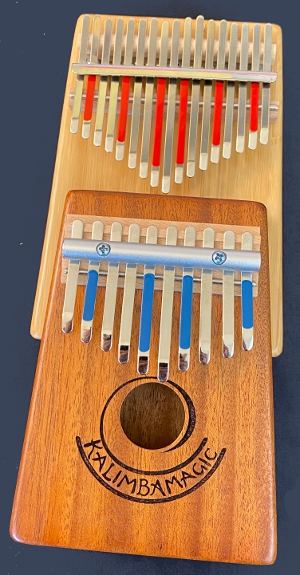
Use of this website constitutes acceptance of the Privacy Policy and User Agreement. Copyright © 2020 Kalimba Magic. All Rights Reserved.
While a lot of people buy the 17-Note kalimbas, I know for a fact that a lot of these sit unplayed. While 17 notes seems small compared to a piano, 17 notes in your hands can be more than you bargained for.

I have just finished a great introductory book for the 10-Note Kalimba in C, and as you can see from the diagram above, the 10-Note kalimba “fits within” the 17-Note kalimba. The notes and the painting marks are the same, until you get to the outer seven notes.
And here is the clever thing: you don’t have to get the 10-Note kalimba. Keep playing on your 17-Note kalimba, but temporarily hide the three leftmost and the four rightmost tines to simplify your kalimba. Hint: cut a sticky note in half and cover the relevant tines: This is a good thing to do when you are starting out, even if you don’t get the Introduction to the 10-Note Kalimba Book or the PDF eBook version.
This is a good thing to do when you are starting out, even if you don’t get the Introduction to the 10-Note Kalimba Book or the PDF eBook version.
 Grow Into Your 17-Notes
Grow Into Your 17-NotesOf course, anything you learn on those inner 10 tines will still be there waiting for you when you unmask your kalimba. And if you still need some help? Perhaps you should check out the Introduction to the 17-Note Kalimba Book. And after that, we have loads of books and downloads, for both your 17-Note Kalimba and for the 10-Note Kalimba.
As you begin to get good at playing the 17-Note Kalimba, turn back and help someone. A child? A neighbor? Your mother? Perhaps a grandchild? Think about you playing the 17-Note Kalimba, and them playing the 10-Note Kalimba. If you restrict yourself to playing the inner 10-Notes, you can demonstrate to your less experienced friend, and they can copy from you.
When they get good and can stand on their own, it might be time to get the 10-Note/17-Note Duets Book. This book has some songs that you will recognize. But more importantly, it teaches you different modalities for playing together.
And one more idea to leave you with. I have been playing kalimba for 35 years. You would think I’d be playing on the 100-Note Kalimba by now, right?
Well, one of the joys of the kalimba is its simplicity. From my perspective:
21 Tines? I don’t think so. 17-Notes? Is plenty for me. 15-Tines? Yes, still enough to do most of what I want.
But when I go walking and I play kalimba, I often choose a kalimba with 8, 9, 10, or 11 tines. Why?
Because these kalimbas with fewer tines tend to have more space between the tines, making them easier to pluck the right tine. This is especially handy when I am walking and not paying quite as much attention to my thumb placement.
In other words, even if you do graduate to all 17-Notes, you may intentionally want to go back and play on that simple 10-Note Kalimba. Every bit of practice you do on the 10-Note translates to the 17-Note.
By the way, the Heart-10 and Heart-17 Kalimbas are on their way out. Until I sell them all, we have a reduced price on them. They are being replaced by the Bamboo 17-Note and the Mahogany 10-Note in the photo above. Both of these have the circular sound hole and the “Kalimba Magic” spiral wood burn design.


Sign up for our newsletter and free resources with your email address:
We pinky promise not to spam you and to only send good stuff.
 Assist Paul Tracey Rebuild His House in Pacific Palisades
Assist Paul Tracey Rebuild His House in Pacific Palisades 8-Note Spiral Kalimba Turned into a Student Karimba
8-Note Spiral Kalimba Turned into a Student Karimba Seek to Infuse Your Musical Moments With Beauty and Magic
Seek to Infuse Your Musical Moments With Beauty and MagicUse of this website constitutes acceptance of the Privacy Policy and User Agreement. Copyright © 2020 Kalimba Magic. All Rights Reserved.